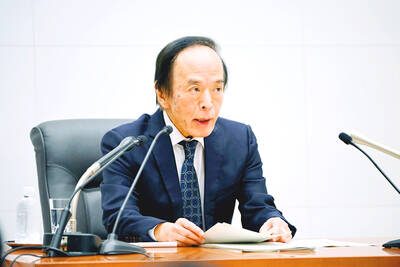The unemployment rate fell last month to its lowest level in nearly five years, an indication that the labor market in Taiwan is stable, the Directorate-General of Budget, Accounting and Statistics (DGBAS) said yesterday.
The jobless rate last month dropped to 4.07 percent from 4.17 percent in March, marking the lowest level since July 2008.
On an annual basis, unemployment fell 0.03 percentage points last month, the DGBAS said in its monthly report.
ACCURATE
However, the seasonally adjusted unemployment rate — a more accurate indicator of the long-term trend — rose for the second consecutive month to 4.19 percent last month from 4.18 percent in March, the DGBAS said.
“The labor market did not show deterioration, but also showed no significant signs of a rebound,” DGBAS deputy director Chen Min (陳憫) told a press conference.
The number of unemployed people decreased by 11,000 to 464,000 last month from a month earlier, with the number of people quitting their jobs due to dissatisfaction down by 5,000, and the number of people losing their jobs as a result of businesses downsizing or factories closing declining by 2,000, the report said.
However, the sluggish trend in export orders signified limited future demand for new employees in the manufacturing sector, Chen said.
Daniel Lee (李大華), a public relations director at manpower agency 1111 Job Bank (1111人力銀行), said the nation’s jobless rate may start rising this month since a large number of first-time jobseekers — who are about to graduate from the education system — are set to enter the job market and raise the seasonal number of unemployed.
The unemployment rate for those aged 20 to 24 stood at 13.04 percent last month, declining by 0.31 percentage points from March, with the rate for 25 to 29-year-olds down 0.31 percentage points from a month ago to 6.87 percent.
The DGBAS yesterday also published the average monthly wage of employees in the industrial and service sectors, which rose 0.74 percent in the first quarter to NT$37,508 from a year ago — the highest level ever recorded.
WAGE DECREASE
However, overall average monthly wages, including bonuses and compensation, dropped 1.64 percent to NT$54,897 in the first three months from a year earlier, as employers distributed fewer bonuses following weak economic sentiment last year, the DGBAS said.
After adjusting for inflation — which climbed 1.81 percent year-on-year in the first three months of the year — real average wages including bonuses and compensation fell 3.39 percent from a year earlier to NT$53,689 in the first quarter to hit the lowest level in four years, agency statistics showed.
The figure was lower than the NT$56,949 real average wage recorded in 1998, indicating that the nation’s wage earners are experiencing a tougher economy now than they did 15 years ago.

Taiwan Semiconductor Manufacturing Co (TSMC, 台積電) last week recorded an increase in the number of shareholders to the highest in almost eight months, despite its share price falling 3.38 percent from the previous week, Taiwan Stock Exchange data released on Saturday showed. As of Friday, TSMC had 1.88 million shareholders, the most since the week of April 25 and an increase of 31,870 from the previous week, the data showed. The number of shareholders jumped despite a drop of NT$50 (US$1.59), or 3.38 percent, in TSMC’s share price from a week earlier to NT$1,430, as investors took profits from their earlier gains

In a high-security Shenzhen laboratory, Chinese scientists have built what Washington has spent years trying to prevent: a prototype of a machine capable of producing the cutting-edge semiconductor chips that power artificial intelligence (AI), smartphones and weapons central to Western military dominance, Reuters has learned. Completed early this year and undergoing testing, the prototype fills nearly an entire factory floor. It was built by a team of former engineers from Dutch semiconductor giant ASML who reverse-engineered the company’s extreme ultraviolet lithography (EUV) machines, according to two people with knowledge of the project. EUV machines sit at the heart of a technological Cold

TAIWAN VALUE CHAIN: Foxtron is to fully own Luxgen following the transaction and it plans to launch a new electric model, the Foxtron Bria, in Taiwan next year Yulon Motor Co (裕隆汽車) yesterday said that its board of directors approved the disposal of its electric vehicle (EV) unit, Luxgen Motor Co (納智捷汽車), to Foxtron Vehicle Technologies Co (鴻華先進) for NT$787.6 million (US$24.98 million). Foxtron, a half-half joint venture between Yulon affiliate Hua-Chuang Automobile Information Technical Center Co (華創車電) and Hon Hai Precision Industry Co (鴻海精密), expects to wrap up the deal in the first quarter of next year. Foxtron would fully own Luxgen following the transaction, including five car distributing companies, outlets and all employees. The deal is subject to the approval of the Fair Trade Commission, Foxtron said. “Foxtron will be

INFLATION CONSIDERATION: The BOJ governor said that it would ‘keep making appropriate decisions’ and would adjust depending on the economy and prices The Bank of Japan (BOJ) yesterday raised its benchmark interest rate to the highest in 30 years and said more increases are in the pipeline if conditions allow, in a sign of growing conviction that it can attain the stable inflation target it has pursued for more than a decade. Bank of Japan Governor Kazuo Ueda’s policy board increased the rate by 0.2 percentage points to 0.75 percent, in a unanimous decision, the bank said in a statement. The central bank cited the rising likelihood of its economic outlook being realized. The rate change was expected by all 50 economists surveyed by Bloomberg. The